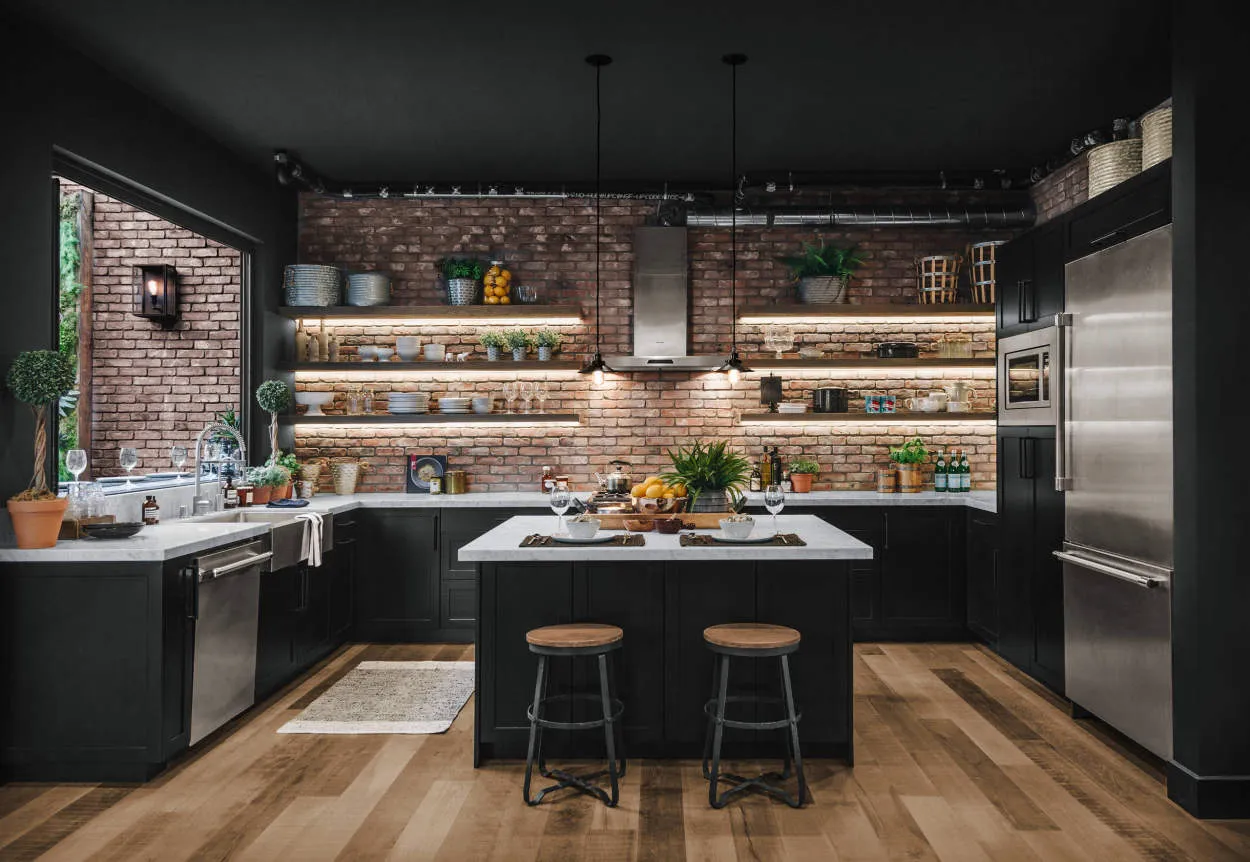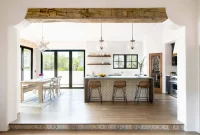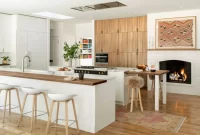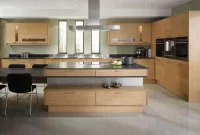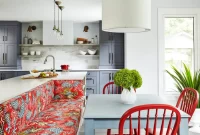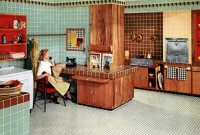Discover the world of industrial kitchen design – where functionality meets style. In this article, we will explore the key elements and provide you with inspiring ideas to transform your kitchen into a sleek and efficient space. From exposed brick walls to stainless steel accents, get ready to be inspired by the industrial aesthetic.
Defining Features of Industrial Style Kitchens
Industrial style kitchens have gained popularity in recent years due to their unique and stylish aesthetic. This design trend draws inspiration from old factories and industrial spaces, resulting in a raw and edgy look. Here are the key defining features of industrial style kitchens:
Exposed Brick Walls
One of the signature elements of industrial style kitchens is the presence of exposed brick walls. These rough, textured surfaces add a rustic charm and create a sense of history and character.
Concrete or Metal Countertops
Industrial kitchens often feature countertops made of concrete or metal. Both materials are durable and have an unfinished look that contributes to the overall industrial aesthetic.
Open Shelving
Instead of traditional upper cabinets, industrial kitchens often incorporate open shelving made of metal or reclaimed wood. This not only creates a more spacious feel but also allows for easy access to frequently used items.
Industrial Lighting Fixtures
The right lighting can enhance the industrial vibe of a kitchen. Hang pendant lights with metal or exposed bulb designs to add a touch of industrial charm. Opt for fixtures with a vintage or distressed look for an authentic feel.
Utilitarian Appliances
Industrial style kitchens often feature utilitarian-style appliances. Stainless steel is a popular choice for appliances as it adds a sleek and industrial touch to the overall design.
Raw Materials
From reclaimed wood to exposed pipes and ducts, incorporating raw materials is essential for achieving an industrial look. Embrace the beauty of imperfections and show off the raw elements that make industrial kitchens truly unique.
Choosing Materials for Durability and Style
In industrial kitchen design, selecting the right materials is essential to ensure both durability and style. The materials chosen should not only withstand the rigorous demands of a commercial kitchen but also contribute to the overall aesthetic appeal. Here are some key considerations when choosing materials for an industrial kitchen:
1. Stainless Steel
Stainless steel is a popular choice for industrial kitchens due to its exceptional durability, resistance to corrosion, and ease of maintenance. It is perfect for countertops, backsplashes, sinks, and appliances. The sleek and professional look of stainless steel adds a modern touch to the kitchen.
2. Concrete
Concrete is another versatile material in industrial kitchen design. It provides a sturdy and long-lasting surface for countertops and flooring. With its natural aesthetic appeal, concrete can be customized with various finishes to achieve a unique look.
3. Brick and Exposed Pipes
Incorporating brick walls and exposed pipes adds an industrial charm to the kitchen design. Exposed brickwork can be used as a feature wall or backsplash, while exposed pipes can be painted or left in their natural state to create an authentic industrial look.
4. Wood
Wood elements add warmth and contrast to industrial kitchens. Use reclaimed or distressed wood for cabinets, shelves, or even as an accent wall. Wood brings a touch of nature into the space and balances out the industrial elements.
5. Glass
Adding glass elements, such as cabinet doors or partitions, can enhance the industrial kitchen design. It brings a sense of transparency while allowing for the display of dishware or other decorative items. Glass also reflects light, making the space appear brighter.
When choosing materials for an industrial kitchen, it is important to consider not only the durability but also the desired style. Mixing different materials can create a unique and visually appealing space that is both functional and aesthetically pleasing.
Industrial Lighting Fixtures for a Bold Statement
In an industrial kitchen design, lighting plays a crucial role in creating a bold statement. The right lighting fixtures can enhance the overall ambiance, highlight architectural features, and improve functionality. Here are some key elements to consider when choosing industrial lighting fixtures for your kitchen:
1. Exposed Bulbs
One characteristic of industrial lighting is the use of exposed bulbs. These bare bulbs showcase the beauty of utilitarian design and add a touch of rawness to the space. You can opt for Edison-style bulbs with their vintage charm or sleek LED filament bulbs for a modern twist.
2. Metal Pendant Lights
Industrial kitchens often feature metal pendant lights. These lights come in various shapes and sizes, such as bell-shaped, dome-shaped, or cage-style designs. The metallic finish adds an industrial flair, while the pendant style provides focused task lighting for cooking areas and dining spaces.
3. Track Lighting
For a versatile lighting solution, consider installing track lighting. This allows you to adjust the position and direction of the lights to suit different needs. Track lighting can be used to highlight specific areas, such as the kitchen island or countertops, while also providing ambient lighting for the entire space.
4. Industrial Chandeliers
To make a bold statement in your industrial kitchen, consider adding an industrial chandelier as a focal point. These chandeliers typically have a combination of metal and exposed bulbs, creating a visually striking centerpiece. Choose a size and style that complements your overall kitchen design.
5. Vintage Sconces
Adding vintage sconces to your kitchen walls can bring a touch of nostalgia. These wall-mounted fixtures provide both functional and decorative lighting. Choose sconces with an industrial design, such as wrought iron or metal finishes, to enhance the industrial theme.
When selecting industrial lighting fixtures for your kitchen, aim for a cohesive and balanced look. Consider the scale and proportions of the fixtures in relation to your kitchen size. Additionally, pay attention to the color temperature of the bulbs to create the desired ambiance. By choosing the right lighting, you can elevate the overall design of your industrial kitchen.
Mixing Industrial Elements with Other Styles
In the realm of interior design, industrial style has gained significant popularity in recent years. This style, reminiscent of old factories and warehouses, brings a raw and edgy vibe to any space. One area where the industrial aesthetic is being creatively incorporated is in kitchen design.
An industrial kitchen design combines rugged elements, such as exposed brick walls, concrete floors, and metal accents, with other styles to create a unique and visually compelling space. The juxtaposition of industrial elements with softer and more traditional elements results in a kitchen that is both functional and stylish.
Elements of Industrial Kitchen Design
To achieve an industrial-inspired kitchen, several key elements can be incorporated:
- Exposed infrastructure: Leaving pipes, ducts, and beams exposed adds to the overall industrial feel.
- Raw materials: Incorporating materials like concrete, stainless steel, and reclaimed wood adds texture and authenticity.
- Open shelving: Displaying kitchenware and ingredients on open shelves enhances the industrial aesthetic while adding functionality.
- Industrial lighting: Utilizing pendant lights or industrial-style chandeliers can complement the overall theme.
Inspiration for Industrial Kitchen Design
Here are a few inspiring ideas to help you incorporate industrial elements into your kitchen:
- Mixing materials: Combine sleek metal cabinets with warm wooden countertops for a balance of industrial and natural aesthetics.
- Statement pieces: Install a large industrial-style island as the centerpiece of your kitchen, complemented by vintage bar stools.
- Exposed brick feature: Highlight one wall with exposed brick to create a focal point that enhances the industrial vibe.
- Industrial color palette: Opt for a palette that includes shades of gray, black, and muted tones to maintain the industrial charm.
Remember, the key to successfully mixing industrial elements with other styles lies in achieving a harmonious balance. By combining rugged and raw materials with softer and more refined ones, you can create a kitchen space that not only reflects your personal style but also adds a touch of industrial allure.
Conclusion
In conclusion, industrial kitchen design incorporates elements of raw materials, exposed infrastructure, and a minimalist aesthetic, creating a unique and functional space. Inspired by factories and warehouses, this design style is perfect for those seeking a modern and contemporary look for their kitchen.

